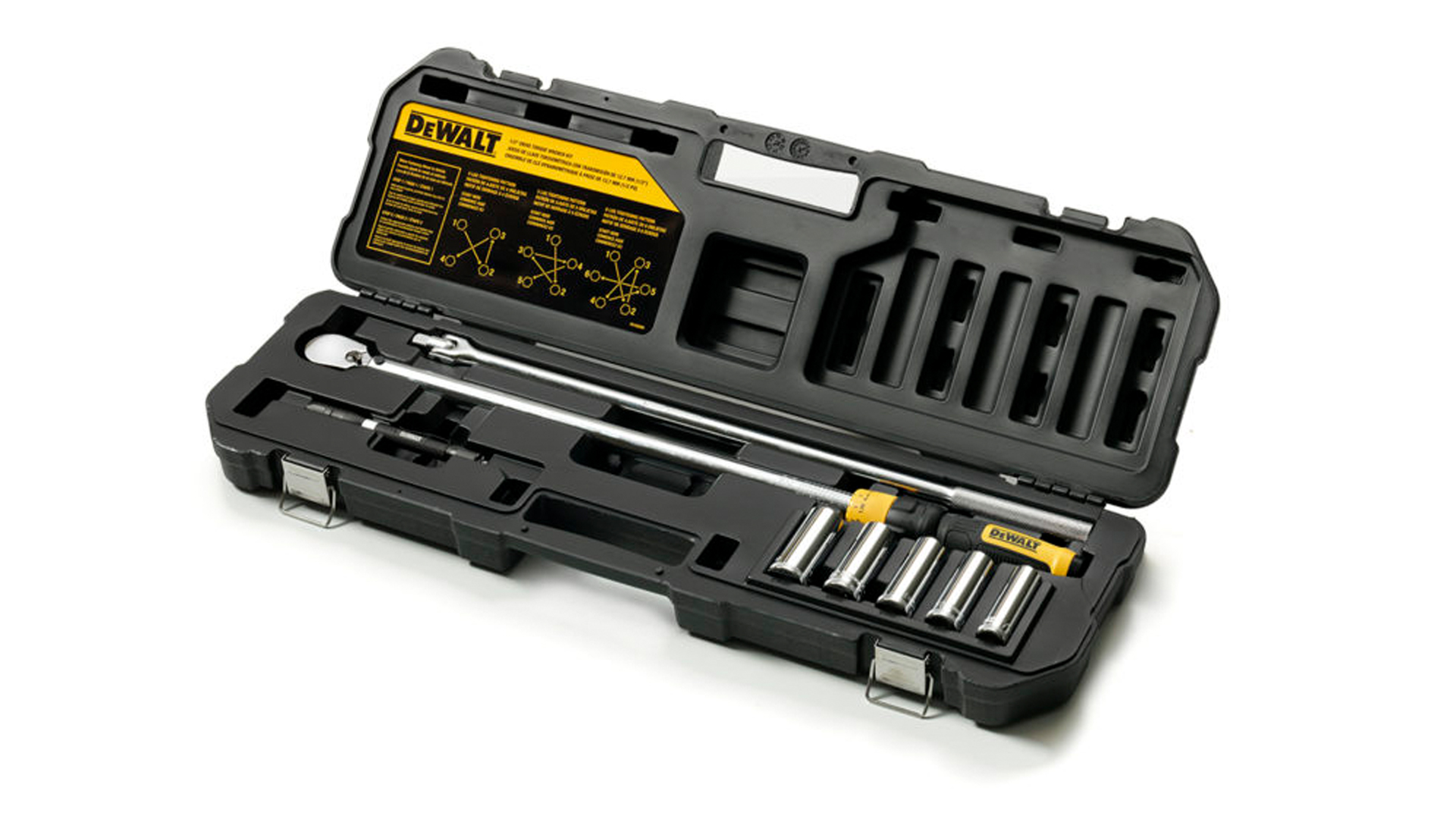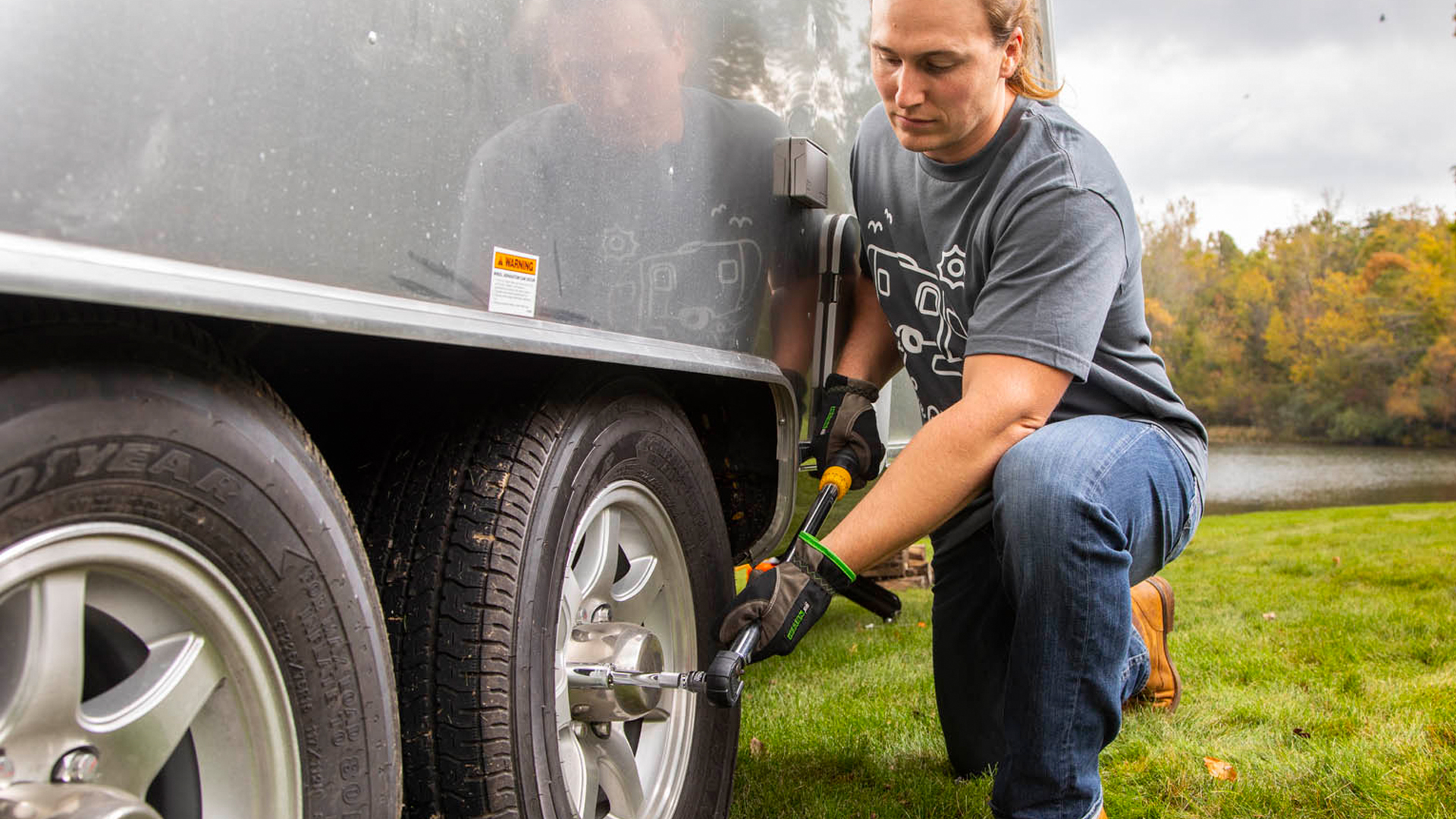Your Airstream is a vehicle for adventure, and when adventure calls you want to be ready to roll. Regular maintenance and inspection of your wheels and tires is an essential practice for all Airstream owners – a habit that helps ensure you can hitch up and hit the road when the time comes.
One of the most important of these regular maintenance habits is to tighten the lug nuts on your Airstream’s wheels. Commonly referred to as “torquing,” this practice is quick and easy – and can end up paying off in dividends down the road. Torquing your lug nuts before every trip buys you peace of mind with the knowledge that you've checked off one of an Airstream’s most important safety procedures.

An Essential – and Easy – Procedure
Properly torquing the lug nuts on your Airstream travel trailer’s wheels is an essential procedure every time you hitch up. While a simple procedure, torquing lug nuts is something that many people have never done before they purchase their first Airstream travel trailer. It’s a procedure that also requires a specific and essential tool: a torque wrench.
What is a Torque Wrench?
A torque wrench is a specialized tool used for making precise adjustments on nuts and bolts. Torque wrenches allow the user to set the exact amount of torque the wrench can apply while tightening a bolt, ensuring accuracy and safety when specific adjustments are required. They come in a variety of sizes, from just a few inches for small jobs to the two-handed tool you’ll need for your Airstream.

Similar to the traditional socket wrenches many people have in their toolbox already, a torque wrench consists of a long-shafted handle and a head with a socket attachment. But unlike a simple socket wrench, finely-tuned mechanisms inside the head of the torque wrench are calibrated so you can set the specific amount of torque the wrench can apply. There are several types of torque wrenches, but one of the most common types has a rotating handle that allows you to set the amount of torque.
Essential tools in machinery maintenance and repair, torque wrenches are often used to tighten the lug nuts on vehicle wheels. Because accurate tightening of the lug nuts on towable RVs is an important safety procedure, understanding how to use a torque wrench is something every RVer should know. This important tool should be in every Airstreamer’s tool kit.
Why Should I Torque My Airstream’s Lug Nuts?
By design, a travel trailer’s wheels carry much higher loads per wheel than the wheels on a passenger vehicle or truck. Each wheel can easily end up supporting over 1,000 pounds each (check your owner's manual for specifics). And because the travel trailer’s wheels are fixed and don’t steer, they are subjected to very high stress as you navigate around a turn. Navigating through slow, tight turns puts especially high stress on the wheels, subjecting them to very high side loads.

This type of stress causes the rims to flex and if left unchecked can gradually loosen the wheel’s lug nuts. Loose lug nuts can result in the wheel coming unseated from its mounted position on the head of the axle, which can lead to uneven wear on your tires – and potentially to a tire blow out. Another term for a flat tire, a tire blowout not only derails your adventure but can involve costly repairs.
Luckily, the lug nut torquing and wheel care procedures we’ve outlined help minimize this possibility. Regularly inspecting your wheels and tires before each trip and torquing your lug nuts according to the recommendations will help ensure that your wheels and tires are ready to hit the road.
How to Properly Torque Your Airstream’s Lug Nuts
Torque is measured in a unit called pound-feet, and it’s usually expressed as a number of pound-feet (ie, 110 pound-feet). Like many concepts in physics the details are complicated, but in general, torque is the measurement of force needed to turn something around a pivot point. In the case of your Airstream’s lug nuts, it’s important to set the torque precisely without over- or under-tightening them. Your torque wrench allows you to accurately set the exact amount of torque you want to apply.
Most torque wrenches come with sockets of varying sizes, but modern Airstream’s use a 21 mm socket. You will also want an extender bar that gives you more clearance to reach the lug nuts with room enough for the handle of the wrench to move freely while you tighten.

For Airstream travel trailers with aluminum wheels, set your torque wrench to 110 pound-feet. If you have an older Airstream with steel wheels, set your torque wrench to 100 pound-feet. Each wheel has six lug nuts. If the wheel is a clock face, start with the lug nut at 12 o’clock. Attach the socket so it’s firmly in place and with two hands rotate the torque wrench in a clockwise direction until you hear the torque wrench click twice.
Moving in a star pattern from nut to nut, proceed through the remaining lug nuts in the same fashion, tightening each until the wrench clicks (some wrenches are different: check the instructions to learn the specific queue that torque has been achieved). Then move on to the other wheels until you’ve tightened all your lug nuts. See this Airstream Support article for a diagram and more information on torquing lug nuts.
This procedure is essential every time you replace a wheel (such as when you change a flat tire or put new tires on your travel trailer). Airstream recommends torquing lug nuts at 10, 25, and 50 miles after a wheel replacement. It is also recommended that you torque your Airstream travel trailer’s lug nuts before every trip.
Airstream Wheel and Tire Care: Peace of Mind for the Journey Ahead
There’s a reason Airstream founder Wally Byam loved to christen his designs with nautical themes like Land Yacht, Caravel, and Clipper: When you hit the road in your Airstream you assume the captain's role. Good captains know the value of preparation ahead of a journey. Along with the freedom to set your own course comes the responsibility to ensure everything is ship-shape.
Torquing your lug nuts and inspecting your wheels and tires should be a part of every pre-departure checklist. Tires should be routinely inspected for weathering, cracking, or significant wear, as these are warning signs that new tires are needed. Checking your tread thickness is equally important and helps you understand how many more miles you have on your tires. For ideal performance, your tires should have at least 2/32” of tread. A quick way to measure this is to use a penny turned so Lincoln’s head is upside down. The top of his head should be covered when inserted into the space between the treads. If you can see Lincoln’s entire head it’s time to start looking for new tires.

When storing your Airstream, there are several essential steps to preventing tire issues down the road. Make sure the tires are properly inflated and that your travel trailer is level. The weight will naturally weaken the seals on tires over time and inactive tires pressed against asphalt can develop dry rot. Using leveling pads or blocks under your tires can help prevent damage during storage. We also recommend using tire covers during storage to prevent the UV rays in sunlight from breaking down the components in the rubber.
Other Important Procedures and Resources
For new Airstream owners, we’ve collected a variety of resources to educate you on common procedures, provide useful checklists and advice, and help you solve issues as they arise. The road to expertise is a well-worn path that thousands have traveled before you – and you don’t have to travel it alone.
Seasoned Airstreamers remember those early days when there seemed to be more questions than answers, and they’re always quick to help out and dispense advice they’ve gained over the years and miles. From other Airstreamers nearby in your campground to the extensive knowledge base on Airstream Support, the Airstream community is ready to help you gain the knowledge you need for a safe, successful trip every time you hitch up.
Learn more about the importance of torquing your lug nuts – including a diagram of the tightening pattern you should follow – with our Airstream Support article.









